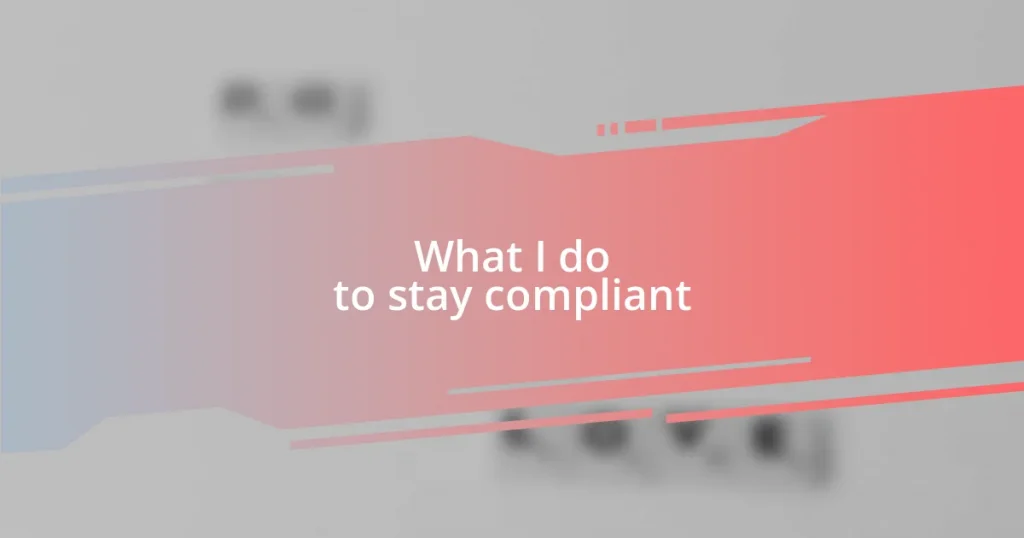Key takeaways:
- Proactive preparation, such as developing checklists and engaging in discussions with peers, enhances understanding and management of compliance requirements.
- Regular audits and stakeholder involvement transform compliance from a static task to an opportunity for teamwork and continuous improvement.
- Staying updated on regulations through newsletters, webinars, and intentional review processes fosters confidence and a proactive approach to compliance management.

Understanding compliance requirements
Understanding compliance requirements can feel overwhelming at times, especially when regulations change frequently. I remember the first time I faced a compliance audit; my heart raced when I realized how much I didn’t know about the requirements. I learned that staying informed is key—regularly reviewing guidelines and seeking resources makes the process more manageable.
When I dive into compliance documents, I often feel like I’m deciphering a different language. It’s important to break down these complex terms into digestible parts. For instance, defining what “risk management” means in your context can provide clarity and direction. Have you ever wondered how other professionals interpret these terms? Engaging in discussions with peers has been invaluable for me—sharing insights often leads to new understandings.
As I’ve navigated compliance, I’ve realized that proactive preparation is critical. I’ve developed a checklist to ensure I meet all requirements before deadlines, which alleviates stress and allows for smoother operations. Doesn’t it feel good to have a plan? Knowing what’s expected of me puts me in the driver’s seat, rather than reacting to issues as they arise.

Developing a compliance strategy
Developing a compliance strategy is essential to ensure you meet regulatory requirements efficiently. When I worked on creating my strategy, it felt like assembling a puzzle where each piece had to fit just right. I started by identifying key areas of focus, which not only involved regulations specific to my industry but also internal policies. It’s fascinating how a well-structured compliance strategy can streamline processes and actually improve overall performance.
I recall a time when I underestimated the importance of stakeholder involvement. Initially, I thought compliance was solely my responsibility. But as I engaged my team in the process, I discovered valuable insights and perspectives that strengthened our approach. By hosting regular meetings to discuss compliance initiatives, I found that it fostered a sense of ownership within the team. Have you experienced similar moments of realization? Incorporating diverse viewpoints can transform a compliance strategy into a more robust framework.
Regularly revisiting and reassessing the compliance strategy is also a crucial step. I remember feeling complacent after implementing my initial plan. It was only when I faced unexpected hurdles that I understood the value of adaptability. Keeping an open line of communication and soliciting feedback helps to refine the strategy over time. How often do you evaluate your current compliance measures? Continuous improvement not only keeps you compliant but also strengthens your organization’s resilience.
| Aspect | Key Focus |
|---|---|
| Initial Development | Identifying key regulations |
| Team Involvement | Fostering ownership through engagement |
| Continuous Assessment | Improving through feedback |

Implementing compliance training programs
Implementing compliance training programs is a dynamic and rewarding aspect of staying compliant. I vividly remember the initial skepticism I faced from my team when I proposed that we invest time in compliance training. To my surprise, once we got started, the energy in the room shifted; employees began to see it not as an obligation, but as an opportunity for growth. I’ve found that incorporating interactive elements like quizzes and role-playing scenarios truly enhances engagement—making the learning process less of a chore and more of a collaborative effort.
Here are some strategies I’ve discovered to maximize the effectiveness of training programs:
– Tailor Content to Your Audience: Understanding your team’s unique needs and learning styles makes a significant difference.
– Use Real-Life Scenarios: Relating compliance rules to everyday challenges they might face can deepen understanding.
– Encourage Open Dialogue: Providing a platform for questions fosters a culture of transparency and learning.
– Regular Refresher Courses: These ensure that compliance training stays relevant as regulations evolve.
– Celebrate Successes: Acknowledging milestones can motivate the team and reinforce the importance of compliance.
In my experience, the most impactful training sessions blend technical knowledge with team-building activities. I once facilitated a workshop where we divided into teams to solve compliance-related puzzles. Watching colleagues collaborate, share ideas, and laugh while navigating complex regulations made me realize the profound impact of an engaging training experience. It’s these memorable moments that foster a culture of compliance, making it not just a series of requirements but an integral part of our organizational ethos.

Utilizing compliance management tools
Utilizing compliance management tools is like having a reliable compass when navigating complex regulations. I remember my first experience with a compliance management platform; it felt like an awakening. Suddenly, I could organize all regulatory requirements in one place, track changes effortlessly, and prioritize tasks without losing sight of deadlines. Have you ever found yourself buried under an avalanche of compliance documents? Those tools can alleviate that chaos, giving you the clarity needed to focus on what truly matters.
I’ve often leaned on software solutions that not only help with tracking but also streamline communication. For instance, using a centralized tool allowed my team to document issues as they arose, facilitating timely discussions and resolutions. This was particularly enlightening during audit preparations when we could quickly retrieve historical data and corrective actions. It was a relief! I couldn’t help but marvel at how much easier compliance could be with the right tools in my toolkit.
Moreover, I’ve discovered that regularly updating these tools is crucial. Adopting a compliance management system isn’t a one-off task; it’s an evolving commitment. I once neglected to update our software, thinking I could coast for a while, and it soon became a source of frustration during a critical review. Reflecting on that experience, I realized that keeping our tools aligned with regulatory changes is essential for maintaining compliance. How often do you check in on your own tools? That proactive approach can save you not just time but also headaches down the line.

Conducting regular compliance audits
Conducting regular compliance audits is a practice that I view as an essential part of my operational routine. The first time I led an audit, I felt a mix of excitement and anxiety. As we combed through our processes, I realized that audits aren’t just about spotting issues; they’re a powerful opportunity to identify strengths and areas for improvement. That feeling when you uncover a flaw and can immediately strategize a fix? It’s invigorating, and it turns compliance into an active dialogue rather than a static checklist.
During one of my audits, I discovered a process that hadn’t evolved with changes in regulation. I felt a rush of concern initially, but as I gathered the team to address it, the atmosphere shifted. We brainstormed solutions, transforming what could have been a setback into a chance to enhance our practices. This demonstrated to me how audits could drive engagement and foster a culture of continuous improvement. Have you ever had a moment like this where an audit not only illuminated compliance gaps but also empowered your team?
The key to effective audits is consistency and communication. I prioritize scheduling them at regular intervals—this keeps compliance a fresh topic rather than a looming deadline. When sharing the audit results, I focus on being transparent about findings. It’s rewarding to see the team come together, motivated not by fear of penalties but by the desire to excel. Making audits a part of our routine has not only enhanced our compliance but also built trust and accountability among my colleagues. Isn’t it remarkable how something as structured as an audit can create a sense of camaraderie and ownership?

Staying updated on regulations
Staying updated on regulations has become a cornerstone of my daily routine. I still vividly recall the first time I stumbled upon a new regulation that could have impacted my business significantly. It was a bone-chilling moment, realizing how easily I could have missed it. Now, I subscribe to industry newsletters and follow regulatory bodies on social media to ensure I’m not left in the dark. Have you ever felt that surge of anxiety when you realize you’ve overlooked a key update?
Furthermore, I’ve found that participating in webinars or industry conferences keeps me not only informed but also connected with others in the field. I remember attending a recent seminar where a regulatory expert detailed impending changes. It was fascinating to hear firsthand insights and ask questions. Engaging with these credible sources sparks excitement about compliance rather than dread—have you experienced that thrilling moment when knowledge transforms your perspective?
Lastly, I often set aside time each week to review ongoing regulatory updates. I’ve created a dedicated folder in my emails just for this purpose, which has become my little sanctuary of knowledge. That small, intentional act makes a world of difference. It’s empowering to know I’m actively managing compliance rather than reacting to it. How do you carve out time to stay informed? I genuinely believe that a proactive approach not only simplifies compliance but also boosts your confidence in decision-making.

Ensuring continuous improvement
Continuous improvement isn’t just a buzzword; it’s a mindset I strive to cultivate daily. I once encountered a project that was consistently falling short of our compliance goals. Instead of resigning myself to this reality, I rallied my team and we dissected the situation together. The collaborative energy we generated opened my eyes—transforming obstacles into stepping stones for growth. Have you ever felt the thrill of turning a challenge into a shared victory?
Reflecting on our experiences fosters an honest dialogue that I find essential. After each audit cycle, we come together for a debrief session, where we openly discuss our findings and brainstorm not just solutions, but long-term improvements. This practice emphasizes that we’re all learning and adapting as a unit. It brings to mind one session where we uncovered a repetitive compliance issue; instead of assigning blame, we mapped out a new process that not only rectified the problem but also streamlined our workflow. How often do you take the time to reflect with your team in a supportive manner?
Engagement tools play a massive role in my strategy for continuous improvement. I implemented a suggestion box for team members to share their ideas anonymously, which has led to several innovative compliance practices I never would have considered. The thrill of seeing a colleague’s suggestion come to fruition is indescribable; it creates a strong sense of ownership. Isn’t it remarkable how empowering your team not only enhances compliance but also builds a culture of camaraderie and shared accountability?













